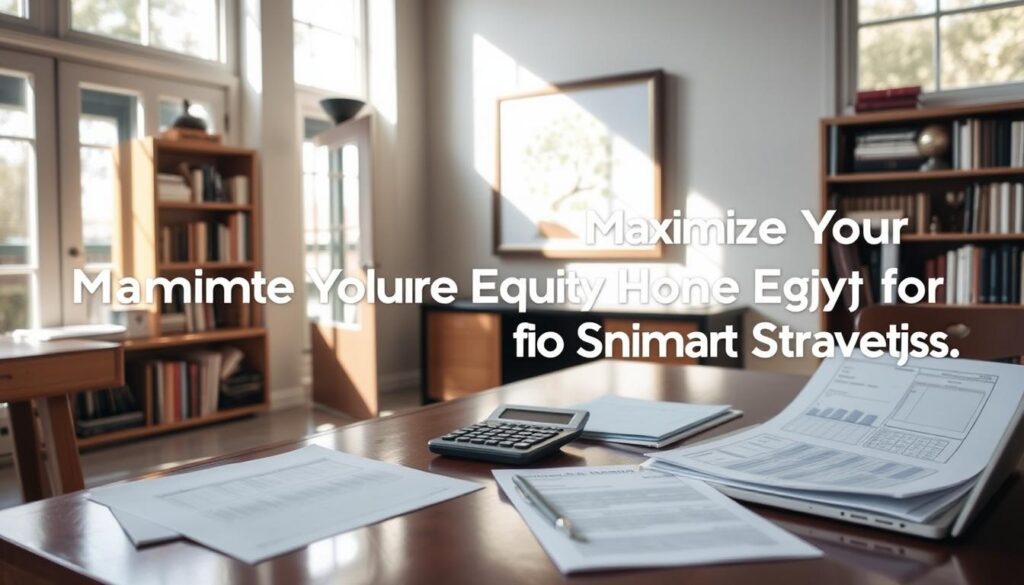Did you know that nearly 40% of U.S. homeowners hold over $300,000 in untapped equity—but fewer than 10% know how to unlock it without debt? Home equity investment offers a path to turn that hidden value into cash today. Imagine accessing funds to renovate, invest, or grow your finances without monthly payments, all while retaining ownership of your home.
A home equity investment lets you sell a share of future home value to an investor for a lump sum. Unlike loans, you avoid interest or repayment schedules. For example, a $500,000 home with $200,000 equity could generate immediate cash while sharing future gains with the investor. This approach, detailed in home equity investment guides, prioritizes flexibility—no debt, no deadlines, just a share of growth when you sell or refinance later.
Whether you’re planning renovations, starting a business, or simply building long-term wealth, this strategy empowers you to leverage your home’s potential. Discover how turning equity into cash today can set the stage for financial freedom tomorrow.
Understanding the Basics of Home Equity
Your home isn’t just a place to live—it’s a key part of your financial journey. Home equity plays a central role in how this asset grows over time. Let’s break down what it means and why it matters.
What Is Home Equity?
Home equity is the portion of your home’s value you truly own. Imagine your house is worth $300,000, and you still owe $150,000 on your mortgage. Your equity? That’s the difference: $150,000. It builds as you pay down loans or home values rise. Think of it as your growing financial asset, ready to unlock opportunities.
Why It Matters to You
This equity isn’t just a number. Here’s why it’s vital:
- It’s a foundation for financial freedom, letting you borrow against it for big goals like education or renovations.
- Higher equity boosts your net worth, making it a measurable step toward long-term stability.
- It acts as a safety net—equity can cover emergencies or fuel investments without draining savings.
Ignoring equity’s potential means missing out on tools that turn your home into a wealth-building machine.
Exploring Home Equity Investment Demystified
Home equity investments offer a path to turn your home’s value into accessible funds. Let’s break down how property equity can work for you, step by step.
How It Works
Here’s the straightforward process:
- Start with prequalification to assess your eligible property equity.
- A professional appraises your home to determine its current market value.
- You receive a lump sum based on your equity share, with no monthly payments.
- Eventually, repayment occurs when you sell or refinance, often tied to home appreciation gains.
Key Strategies for Success
Maximize your benefits with these smart moves:
- Focus on properties with steady appreciation potential.
- Shop for programs with transparent terms to avoid hidden fees.
- Use funds strategically—for home improvements or debt consolidation—to boost long-term value.
Every decision should align with your financial goals. Stay informed to make the most of your property equity’s potential!
Assessing Your Home’s True Potential
Knowing your home’s worth starts with understanding its potential in real estate financing. Market trends and property improvements play a big role here. Here’s how to start:
- Research recent sales of similar homes in your area.
- Check online tools like Zillow or Redfin for price estimates.
- List recent upgrades, like a new kitchen or bathroom, to see their impact.
A professional appraisal gives the most accurate value, but you can also use comparative methods. Here’s how approaches differ:
| Method | Description | Best For |
|---|---|---|
| Comparative Market Analysis | Looks at sold properties to estimate value. | Quick estimates before major decisions. |
| Professional Appraisal | Full inspection by a licensed appraiser. | Loan applications or major real estate financing moves. |
| Automated Valuation Models | Online tools using public data for instant results. | Early-stage research or curiosity checks. |
Track local trends too—like rising home prices or zoning changes. This helps spot growth areas. Small updates could boost equity, so prioritize cost-effective fixes first. Knowing these steps builds a strong foundation for smart real estate financing choices.
Steps to Calculate Your Home Equity
To maximize your home equity potential and boost cash flow improvement, calculating your equity accurately is the first step. Let’s break down the process simply.
Gathering Your Financial Data
Start by collecting these documents:
- Current mortgage balance (check loan statements)
- Property tax records (available via local tax office websites)
- Home improvement receipts (track upgrades affecting value)
- Original purchase price and closing costs
Understanding Valuation Methods
Choose the right method to reflect your property’s true value:
| Method | How It Works | Best For |
|---|---|---|
| Market Comparison | Compares recent sales of similar homes | Active real estate markets |
| Cost Approach | Estimates land value plus reconstruction costs | Unique or custom-built properties |
| Income Approach | Uses rental income potential to assess value | Investment properties |
Once you’ve calculated your equity using these steps, you’ll have clearer insights to plan cash flow improvement strategies like refinancing or home equity loans. Keep all documents updated for accurate tracking over time.
Tips for Maximizing Your Home Equity
Boost your home equity with smart investment strategies that turn your property into a wealth-building asset. Here’s how to grow your equity faster:
- Refinance for lower rates. Switching to a lower-interest loan cuts monthly costs, freeing cash to reinvest in home upgrades or pay down principal faster.
- Target high-ROI upgrades. Kitchen and bathroom remodels add value. Energy-efficient windows or modern flooring appeal to buyers and boost resale prices.
- Accelerate principal payments. Extra mortgage payments directly increase equity. Even small monthly boosts compound over time.
- Track local market trends. Time renovations or sales when demand peaks. Research neighborhood sales to align improvements with buyer preferences.
Consistent action turns small steps into long-term gains. Start with one strategy today to see equity grow steadily.
Choosing the Right Home Equity Investment Approach
Your home equity investment strategy depends on balancing stability and flexibility. Start by comparing fixed-rate and adjustable-rate options. Fixed rates offer predictable payments, while adjustable options may fluctuate with market changes. Both paths come with pros and cons.

Consider these factors when deciding between fixed and adjustable plans:
- Current interest rate trends
- Your tolerance for financial uncertainty
- Long-term housing market forecasts
Weighing home equity investment risks requires evaluating both scenarios:
- Market volatility impacting property values
- Interest rate shifts altering repayment terms
- Personal financial goals alignment
Research from HEIExplained shows 68% of investors prioritize fixed-rate options for stability. Yet adjustable plans can offer lower initial costs in stable economies. Always assess how each choice fits your budget and future plans.
Use online calculators to simulate different scenarios. Ask lenders about worst-case rate caps. Remember, the best approach adapts to your unique financial picture.
Navigating the Investment Process
Unlock wealth begins with understanding the steps to turn home equity into actionable funds. The process, while structured, is designed to be manageable if approached methodically. Let’s outline the key phases to ensure smooth progress.
The Application Journey
Start by securing prequalification with lenders. This step reveals available loan amounts and terms tailored to your equity. Next, a professional appraisal confirms your home’s current value—critical for determining loan limits. Gather financial records, including tax returns and bank statements, to speed up approval. Submit your application with all required documents. Once approved, funds are disbursed as agreed.
- Prequalification: Get preliminary terms from lenders.
- Appraisal: A certified assessor evaluates your home’s market value.
- Application: Submit documents like pay stubs and ID for review.
- Disbursement: Funds arrive via check, direct deposit, or other agreed methods.
Stay proactive by reviewing contracts thoroughly and asking questions. Clear communication with lenders keeps the process on track. Patience and preparation help avoid delays, ensuring you unlock wealth efficiently. Every step brings you closer to accessing capital without unnecessary stress.
Avoiding Common Pitfalls in Home Equity Investment
Home equity investments can pave the way to financial freedom, but hidden risks demand your attention. Mistakes here could delay your goals or lead to unexpected costs. Stay alert to red flags and adopt smart strategies to protect your progress.
Identifying Potential Red Flags
- Shared appreciation clauses favoring lenders over your financial freedom plans.
- Hidden fees inflating total costs beyond initial estimates.
- Loan terms with unclear repayment triggers or timelines.
Effective Mitigation Strategies
- Review contracts line by line. Ensure all terms—especially appreciation splits—are transparent.
- Shop for quotes from multiple lenders to compare rates and conditions.
- Build a contingency fund to cover unexpected delays or market dips.
Proactive steps like these turn risks into manageable challenges. Protecting your equity safeguards your path to long-term stability and financial freedom. Always ask questions and seek clarity before finalizing agreements.
Leveraging Your Equity for Future Opportunities
Your property equity isn’t just a number—it’s a tool. Unlocking its potential starts with understanding your options. Whether you’re eyeing a kitchen remodel or paying off debt, these strategies turn home value into actionable funds.
Exploring Refinancing Options
Cash-out refinancing swaps your current loan for a larger one, giving you cash from your equity. This lump-sum approach works well for big projects. For details, explore cash-out options tailored to your goals. Common uses include:
- Updating kitchens or bathrooms
- Paying off high-interest loans
- Medical or educational expenses
| Option | Cash-Out Refinance | HELOC |
|---|---|---|
| Access | One-time lump sum | Ongoing withdrawals |
| Interest | Fixed or adjustable rates | Variable rates |
| Risk | Long-term repayment terms | Line of credit balance |
Utilizing Home Equity Lines (HELOC)
A HELOC functions like a credit card secured by your home. Borrow, repay, and reuse funds as needed. Ideal for staggered projects or covering unexpected costs, it offers flexibility but requires careful budgeting. Both options tie into your property equity, so evaluate terms and risks before choosing.
Maintaining a Healthy Financial Outlook
Managing your finances wisely ensures your home equity remains a strength, not a burden. Real estate financing requires balancing debt with long-term goals. Start by tracking monthly expenses to avoid over-leveraging. Experts suggest keeping mortgage payments below 28% of your income.
- Review loans annually to match your income growth
- Set aside emergency funds to cover 3-6 months of living costs
- Consult with a financial advisor before taking on new debt
| Smart Moves | Risky Moves |
|---|---|
| Reinvesting profits into property upgrades | Using equity for non-essential purchases |
| Regular credit score monitoring | Ignoring interest rate trends |
| Building an emergency savings cushion | Maxing out home equity lines of credit |
Regularly assess your real estate financing choices to align with life changes like career shifts or family growth. Diversify investments beyond property to reduce risk exposure. A stable financial outlook protects your equity while allowing smart growth opportunities.
Advanced Strategies for Home Equity Growth
Unlocking the full potential of your home equity requires thinking beyond traditional methods. Advanced strategies focus on creative techniques that boost cash flow improvement and long-term wealth. Let’s explore actionable steps to amplify your financial gains.
Creative Investment Techniques
Try these proven methods to maximize returns:
- Refinance to shorter-term loans (e.g., 15-year mortgages) to reduce interest costs
- Use unexpected windfalls (tax refunds, bonuses) to make extra principal payments
- Rent out underused spaces to generate supplemental income
Long-Term Wealth Building
Building equity over decades requires patience and discipline. Consider:
| Strategy | Goal | Example |
|---|---|---|
| Equity compounding | Accelerate growth through consistent payments | Automate biweekly mortgage payments |
| Smart diversification | Spread risk while boosting equity | Invest in home upgrades that increase resale value |
Pair these steps with regular market analysis. For instance, track local housing trends using platforms like Zillow or Redfin to time sales or renovations. Prioritizing cash flow improvement ensures your equity grows without sacrificing immediate financial stability.
Conclusion
Your home’s equity holds significant potential, and this guide has outlined practical investment strategies to unlock it. From calculating your equity accurately to choosing between fixed-rate or adjustable options, each step empowers you to make decisions that align with your financial goals. The strategies discussed—like avoiding common pitfalls, refining valuation methods, and exploring lines of credit or refinancing—provide a roadmap to grow wealth responsibly.
Remember, leveraging home equity isn’t just about short-term gains. The long-term strategies highlighted, such as creative techniques and maintaining a healthy financial outlook, ensure sustained growth. By applying these steps, you position yourself to turn your home into a dynamic asset. Whether you’re planning for home improvements, education, or retirement, the tools here help you navigate choices with confidence.
Investment strategies require careful consideration, but with the knowledge gained here, you’re equipped to act. Start by reviewing your current equity position and explore how incremental steps can build lasting value. Stay informed, stay proactive, and let your home’s equity work for you. Your journey toward financial empowerment begins with the strategies outlined here—take the next step today.



